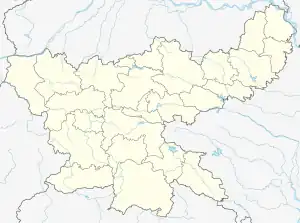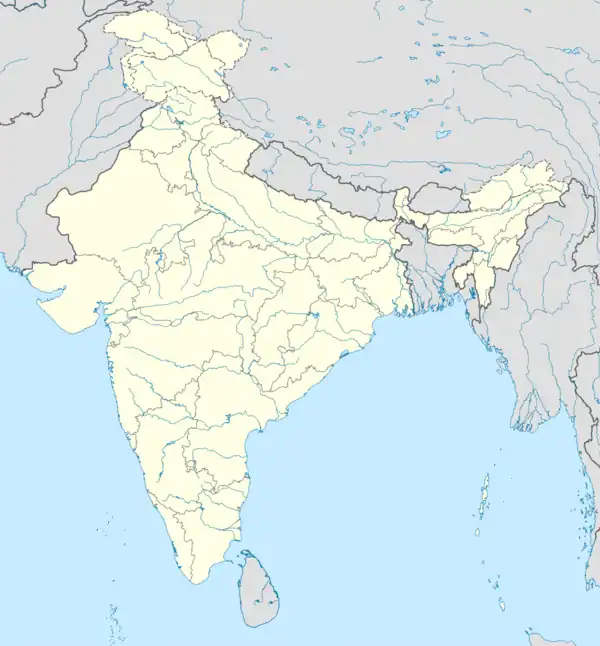Kisko block
Kisko block is a CD block that forms an administrative division in the Lohardaga subdivision of Lohardaga district, in the Indian state of Jharkhand.
Kisko | |
|---|---|
Community development block | |
 Kisko Location in Jharkhand  Kisko Kisko (India) | |
| Coordinates: 23.5184°N 84.6657°E | |
| Country | |
| State | Jharkhand |
| District | Lohardaga |
| Government | |
| • Type | Federal democracy |
| Area | |
| • Total | 253.29 km2 (97.80 sq mi) |
| Population (2011) | |
| • Total | 54,959 |
| • Density | 220/km2 (560/sq mi) |
| Languages | |
| • Official | Hindi, Urdu |
| Time zone | UTC+5:30 (IST) |
| PIN | 835302 |
| Telephone/STD code | 06526 |
| Vehicle registration | JH 08 |
| Literacy | 64.54% |
| Lok Sabha constituency | Lohardaga |
| Vidhan Sabha constituency | Lohardaga |
| Website | lohardaga |
History
Lohardaga was made a subdivision of Ranchi district in 1972. Ranchi district was split into three districts namely Ranchi, Gumla and Lohardaga, in 1983.[1]
Maoist activities
Lohardaga has been identified as an “A” grade highly Maoist infested district. Kuru, Bhandra, Kairo, Kisko, Jowang and Senha police stations are totally affected and Lohardaga police station is partially affected. The Maoist outfits are mainly interested in extorting the bauxite mining and transport industry. The police force has been trained to take on the Maoist outfits and has been extending support at important points. Lohardaga has lost one Superintendent of Police, Ajay Kumar Singh, IPS in the anti-insurgency operations.[2]
Geography
Kisko is located at 23.5184°N 84.6657°E.
Lohardaga district consists of two broad physiographic divisions – the hilly tract and the plateau region. The hilly tract extends over the western and north-western parts of the district. The high hill tops of this region are known as pat. The plateau region is a part of the Gumla Plateau, which lies in the southern portion of Chota Nagpur Plateau. Lohardaga and Bhandra CD blocks are entirely in the plateau region. Other administrative areas, such as Kisko, Senha and Kuru CD blocks are partly in the plateau region and partly in the hilly tract.[3]
Kisko CD block is bounded by the Latehar CD block in Latehar district on the north, Kuru and Lohardaga CD blocks on the east, Senha CD block on the south and Peshrar CD block on the west.[4][5]
Kisko CD block has an area of 253.29 km2.[6] Kisko police station serves Kisko CD block.[7] The headquarters of Kisko CD block is located at Kisko village.[8]
Demographics
Population
According to the 2011 Census of India, Kisko CD block had a total population of 54,959, all of which were rural. There were 27,692 (50%) males and 27,267 (50%) females. Population in the age range 0–6 years was 9,373. Scheduled Castes numbered 1,663 (3.03%) and Scheduled Tribes numbered 33,559 (61.06%).[6]
Literacy
According to the 2011 census, the total number of literate persons in Kisko CD block was 29,422 (64.54% of the population over 6 years) out of which males numbered 17,212 (74.89% of the male population over 6 years) and females numbered 12,210 (54.02% of the female population over 6 years). The gender disparity (the difference between female and male literacy rates) was 20.87%.[6]
As of 2011 census, literacy in Lohardaga district was 78.62%. Literacy in Jharkhand was 67.63% in 2011.[9] Literacy in India in 2011 was 74.04%.[10]
See also – List of Jharkhand districts ranked by literacy rate
| Literacy in CD Blocks of Lohardaga district |
|---|
| Lohardaga subdivision |
| Kisko – 64.54% |
| Peshrar – 54.25% |
| Kuru – 67.36% |
| Kairo – 64.36% |
| Lohardaga – 67.73% |
| Senha – 66.06% |
| Bhandra block – 63.27% |
| Source: 2011 Census: CD block Wise Primary Census Abstract Data |
Rural poverty
70-80% of the population of Lohardaga district were in the BPL category in 2004–2005.[13] In 2011-12, the proportion of BPL population in Lohardaga district came down to 38.0%.[14] According to a study in 2013 (modified in 2019), "the incidence of poverty in Jharkhand is estimated at 46%, but 60% of the scheduled castes and scheduled tribes are still below poverty line."[15]
Economy
Livelihood
Livelihood
in Kisko CD block
In Kisko CD block in 2011, amongst the class of total workers, cultivators numbered 12,209 and formed 42.13%, agricultural labourers numbered 13,288 and formed 45.85%, household industry workers numbered 652 and formed 2.25% and other workers numbered 2,832 and formed 9.77%. Total workers numbered 28,981 and formed 52.73% of the total population, and non-workers numbered 25,978 and formed 47.27% of the population.[16]
Infrastructure
There are 52 inhabited villages in Kisko CD block. In 2011, 10 villages had power supply. 5 villages had tap water (treated/ untreated), 52 villages had well water (covered/ uncovered), 48 villages had hand pumps, and all villages have drinking water facility. 9 villages had post offices, 10 villages had sub post offices, 5 villages had telephones (land lines), 13 villages had mobile phone coverage. 52 villages had pucca (paved) village roads, 6 villages had bus service (public/ private), 13 villages had autos/ modified autos, 7 villages had taxi/vans, 18 villages had tractors. 7 villages had bank branches, 5 villages had agricultural credit societies, 21 villages had public distribution system, 32 villages had assembly polling stations.[17]
Agriculture
Large areas of the district were earlier covered with forests. With gradual deforestation, more land is being brought under cultivation. At present around 32-35% of the total area is covered with forests. Rice is grown in the terraced lowlands called don. In the uplands called tanr, a coarse form of rice, millets, pulses and oil seeds are grown. Agriculture is mostly monsoon-dependent. “The wells, springs and ahars are the only traditional sources of irrigation. The average land holding per household is 1.65 Ha. The per capita agriculture land is around 0.28 Ha. Net irrigated area is 13.4% of net sown area”.[18]
Bauxite
Bauxite is the raw material from which aluminium is produced. Lohardaga district has large reserves of world class bauxite across Pakhar, Hisari, Rudhali Pat, Khamar Pat and the mining area also extends to neighbouring districts. The district has approval of mining of approximately 11 lakh tones of bauxite mineral in a year. Hindalco Industries Ltd has 7 mining leases out of 9 active mines in Lohardaga district which supplies bauxite to Hindalco’s aluminium plants at Muri and Renukoot.[19][20] A ropeway connecting Bagru mines and Lohardaga has been a popular tourist attraction.[21]
Backward Regions Grant Fund
Lohardaga district is listed as a backward region and receives financial support from the Backward Regions Grant Fund. The fund, created by the Government of India, is designed to redress regional imbalances in development. As of 2012, 272 districts across the country were listed under this scheme. The list includes 21 districts of Jharkhand.[22][23]
Education
Kisko CD block had 18 villages with pre-primary schools, 47 villages with primary schools, 24 villages with middle schools, 5 villages with secondary schools, 2 villages with senior secondary schools, 4 villages with no educational facilities.[24]
.*Senior secondary schools are also known as Inter colleges in Jharkhand
Healthcare
Kisko CD block had 2 villages with primary health centres, 9 villages with primary health subcentres, 3 villages with maternity and child welfare centres, 5 villages with allopathic hospitals, 3 villages with dispensaries, 2 villages with veterinary hospitals, 3 villages with family welfare centres, 1 village with medicine shop.[24]
.*Private medical practitioners, alternative medicine etc. not included
References
- "Lohardaga, About District, History". District administration. Retrieved 4 October 2021.
- "District Police Profile Lohardaga". Security Scenario. Jharkhand Police. Retrieved 4 October 2021.
- "District Census Handbook, Lohardaga, Series 21, Part XII A" (PDF). Page 9: Physical features. Directorate of Census Operations Jharkhand. Retrieved 1 October 2021.
- "Lohardaga CD block/ Tehsil map". Maps of India. Retrieved 1 October 2021.
- "Latehar CD block/ Tehsil map". Maps of India. Retrieved 1 October 2021.
- "District Census Handbook, Lohardaga, Series 21, Part XII B" (PDF). Page 27-29: District primary census abstract, 2011 census. Directorate of Census Operations Jharkhand. Retrieved 30 September 2021.
- "District Police Profile - Lohardaga". Jharkhand Police. Retrieved 30 September 2021.
- "District Census Handbook, Lohardaga, Series 21, Part XII A" (PDF). Map of Loharda+ga district on the fifth page. Directorate of Census Operations Jharkhand. Retrieved 30 September 2021.
- "Provisional Population Totals Paper 1 of 2011: Jharkhand". Provisional Population Totals, Literacy Rate in 2011 column. Registrar General and Census Commissioner, Government of India. Retrieved 1 October 2021.
- "Ranking of states and union territories by literacy rate: 2011" (PDF). Page 110. Government of India. Retrieved 1 October 2021.
- "Table C-15 Population by Religion - Jharkhand". censusindia.gov.in. Registrar General and Census Commissioner of India. 2011.
- "Table C-16 Population by Mother Tongue: Jharkhand". Census of India. Registrar General and Census Commissioner of India.
- "Rural Poverty in Jharkhand, India" (PDF). Table I: Spatial Distribution of Poverty in Jharkhand. Munich Personal RePEc Archive. Retrieved 1 October 2021.
- "Spatial poverty in Jharkhand". Mint. Retrieved 1 October 2021.
- "Rural Poverty in Jharkhand, India: An Empirical Study based on Panel Data". MPRA. Retrieved 1 October 2021.
- "District Census Handbook 2011 Lohardaga, Series 21, Part XII A" (PDF). Tables 30 and 33, pages 40 and 44. Directorate of Census Operations, Jharkhand. Retrieved 1 October 2021.
- "District Census Handbook, Lohardaga, 2011, Series 21, Part XII A" (PDF). Pages 201-202, Appendix I: Village Directory. Directorate of Census Operations, Jharkhand. Retrieved 1 October 2021.
- "District Census Handbook Lohardaga, 2011, Series 21, Part XII A" (PDF). Page 10. Directorate of Census Operations, Jharkhand. Retrieved 4 October 2021.
- "Lohardaga, Mines and Minerals". District administration. Retrieved 5 October 2021.
- "District Census Handbook Lohardaga, 2011, Series 21, Part XII A" (PDF). Page 10. Directorate of Census Operations, Jharkhand. Retrieved 5 October 2021.
- "District Census Handbook Lohardaga, 2011, Series 21, Part XII A" (PDF). Title feature on the seventh page. Directorate of Census Operations, Jharkhand. Retrieved 5 October 2021.
- "Backward Regions Grant Funds: Programme Guidelines" (PDF). Ministry of Panchayati Raj, Government of India. Archived from the original (PDF) on 30 October 2017. Retrieved 4 October 2021.
- "Backward Regions Grant Fund". Press Release, 14 June 2012. Press Information Bureau, Government of India. Retrieved 4 October 2021.
- "District Census Handbook Lohardaga, 2011, Series 21, Part XII A" (PDF). Pages 201-202. Directorate of Census Operations, Jharkhand. Retrieved 4 October 2021.